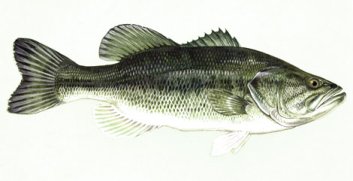September 3rd, 2005

“While it is normal for seabirds to suffer periodic failures, the frequency seems to have been increasing in recent years.”
- 45% of EU seabirds nest on the coasts of Scotland
- On St Kilda only 26% of Puffin burrows produced chicks compares with 71% in a ‘normal’ season
- Canna’s kittiwake colony of about 1 000 pairs saw 5 chicks leave the nest, and on Eigg only 15 kittiwakes were seen against 5 000 normally
- At Ceann a’ Mhara 2,173 birds were found in a census but only 4 guillemots chicks were seen against 1,500 chicks in a ‘normal’ year
- On Papa Westray 1050 adult arctic terns were seen but only one chick, Fair Isle reporting a complete failure – no chicks
The common pattern appears to be that late breeding species are doing badly. A shortage of sandeels – a common food source – caused low numbers last year, but this year some observers have noticed species looking for alternative food sources such as white fish (pollock), but this food has less nutritional yield for the chicks.
Your turn
- Calculate the percentage drop in guillemot chicks compared with a normal year
- Calculate the percentage of kittiwakes seen on Eigg compared with a normal year
These are very small percentages – for the second year running – hence the concern
Posted in Notes | Comments Off
September 2nd, 2005
Halving the rate of change does not stop the forest shrinking, but the shrinking will slow down. Many environmental organisations point out that these figures can’t show a permanent trend yet. The Brazillian government hopes that the fall in destruction of the rainforest is in response to a tightening of the regulations.
Suppose we say the annual rate continues to fall by a factor of two each year. Starting at 18000, we get a series like 9000 and 4500, 2250, 1125, 562.5, 281.25 and so on. Each successive year is adding in a smaller contribution to the total loss. After 10 years, you are looking at a loss of 18 Km2 or roughly one thousandth of the loss in 2003 (210 = 1024). This series is called a geometric progression that happens to have a fractional ‘growth rate’ – like compound interest in reverse.
Plotting the series against year in Excel, you get something like
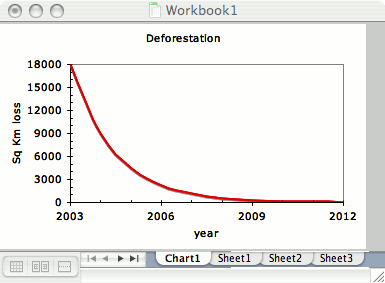
If we do a running subtotal of the loss assuming that the loss is halved each year – rather like a cumulative frequency curve in statistics, the result looks something like this…
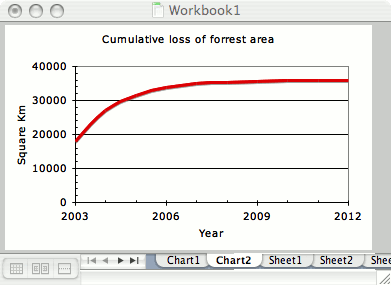
As you can see, the total loss will approach around 36 000 Km2 and each subsequent year will add a smaller and smaller amount, so that the total will never quite reach twice the starting figure. The sequence tends to a limit of twice the starting rate.
Challenges
- can you devise a spreadsheet that will calculate the deforestation for each year and the cumulative total?
- If the deforestation actually ‘grows’ by a factor of 0.75 instead of 0.5 each year, what will the new limit be? Use your spreadsheet to find out. You may need to change the formulas
- Can you use the formula from the Wikipedia page for the sum of an infinite geometric progression to work out what the maximum loss to the rainforest will be based on a growth rate of 0.5 per year? hint – write the sequence like 18000 × ( 1 + 0.5 + 0.25 + 0.125…) and identify X in the wikipedia formula…
We have built a simple mathematical model of deforestation of the Amazon rainforest. Alas I suspect the assumption of halving each year is going to be too optimistic. We can hope.
Posted in Notes | Comments Off
September 1st, 2005
“Welcome to the web site for the Dihydrogen Monoxide Research Division (DMRD), currently located in Newark, Delaware. The controversy surrounding dihydrogen monoxide has never been more widely debated, and the goal of this site is to provide an unbiased data clearinghouse and a forum for public discussion.”
Read the rest of this entry »
Posted in Notes | Comments Off
August 31st, 2005
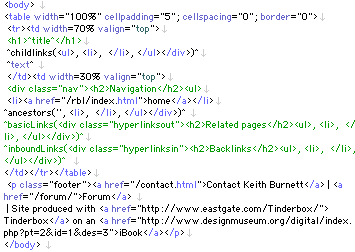
Tinderbox allows a quick and dirty HTML export template and the construction of a course web site in a very short time. Having analysed my work habits, running a couple of course sites off Tinderbox on the iBook will probably save time compared to using a full WordPress installation or skimping with Blogger.
Tinderbox is client side (runs on your local computer – Apple Mac at present but soon Windows – and you have to define an export template for your collection of notes. The template above allows me to do seriously radical editing of the linking structure by dragging and dropping an outline. Just right for when you are modifying a structure in response to feedback. The software is easy to get started with (I’m productive after 1 hour with the PDF manual) but is deep – agents and actions can provide automatic indexing and customised actions.
Tinderbox is mainly a note taking application (styled text and bitmap images stored in one large XML file per project – no tables alas – but ‘notes’ can be manipulated in an amazing variety of ways) but can export notes as a coherent Web site with relative linking. Not cheap at $165 – ¬£100 or so – initial purchase plus $70 per year for updates but nice, deep, software with good support. I have not managed to crash it yet, and I’m throwing all kinds of JPGs and Preview scraps into my ‘misc notes’ file.
Posted in ILT, Notes | Comments Off
August 30th, 2005
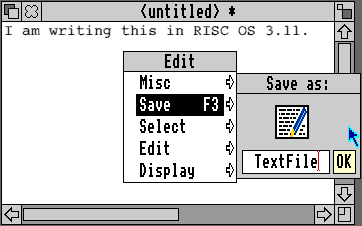
- Graphical User Interface Gallery is a superb web project that is gathering screen shots of major GUIs over the last 20 years or so
- The RISC-OS computers (RISC-OS 2 and 3) were my introduction to GUI based computers. The Archimedes 310 and my own A3000 (for which I paid a small fortune in 1992 money) were ‘monotonous’ in Jeff Raskin’s sense – there was either just one or a very small number of ways of doing things like saving a file. This meant that children in primary school (a major market) could learn to use the computer very quickly.
The GUIdebook has spotted the peculiarity of the RISC-OS save box – there was no menu on the window, no visible representation of the method of saving a file at all. You clicked the middle mouse button over any application window to bring up the Save As dialog box. You were then forced to drag the resulting icon to a filer window to save the file.
The ‘menu’ button (and the absence of a window bar menu) was blamed at the time for the demise of the Acorn computer – schools in the mid 90s were involving parents far more, and had devolved budgets. What Neal Stephenson once referred to as ‘the army of balding Dads’ who ‘know about computers’ were drafted into schools to help with purchasing and replacement of IT equipment.
Such people knew Dos and Windows 3.11, and they could never work out how to save a file on the Acorn computers because of the absence of window menus and the ‘hidden’ menu button on the three button mouse. So the ‘expert’ had to ask a 7 year old how to perform a trivial operation like saving a file…. and schools started to buy ‘industry standard’ computers!
I’m not sure how seriously this was meant to be taken at the time – it was a USENET post – but I know that a lot of schools and Colleges went over to PCs in the early 1990s. I only began to take Microsoft and Windows seriously when Windows 95 came out – it took very little time to habituate to the new system.
End of nostalgia.
Posted in ILT, Notes | Comments Off
August 30th, 2005
...theories of learning is that there are so many to choose from.
Posted in ILT, Notes | Comments Off
August 29th, 2005
Posted in Notes | Comments Off





